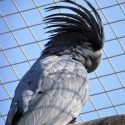
Goliath Palm Cockatoo Natural History
Size
These large cockatoos live up to their name. They reach 60 inches length, with a 100cm wingspan and weigh up to 1.2.kg. When excited they can make themselves look even bigger by raising their crest feathers.
Habitat and Distribution
This species is found in the forests and savannahs of Australia and New Guinea (Indonesia and Papua New Guinea).
Age
The lifespan of Goliath Palm Cockatoo is unknown in the wild but could reach up to 80 in captivity.
Diet
They feed mostly on nuts and fruits of the kanari tree (a type of palm) as well as other fruits, nuts, berries, buds and seeds.
Groups and Breeding
Goliath Palm Cockatoos build nests that differ from many other cockatoos. They lay their eggs in nests without a roof, however their eggs are laid upon a bed of twigs which allows the rainwater to pass through. Females lay one egg at a time and they take 30 days to gestate. Chicks leave the nest at around three months of age but will be fed by their parents for another six weeks. They reach physical maturity at five to six months old and are sexually mature after seven to eight years.
These monogamous birds mate for life and pairs can be very territorial in guarding their nesting sites.
Threats
This species is listed as Near Threatened on the IUCN Red List. However, their numbers are declining with the main threat coming from the destruction of their habitat, in particular their nesting sites due to climate change and fire. They are also trapped for the illegal pet trade and pets (such as feathers) used in local handicrafts, while they are also eaten in small numbers.
Interesting Facts
Out of any parrot species in the world they have the lowest natural breeding success rate and generally only breed every other year.
The Goliath Palm Cockatoos During Your Day Out in Kent
At Wingham Wildlife Park the Goliath Palm Cockatoos, Nora and Johnny can been seen in their new enclosure between two pairs of Hyacinth Macaws, next to our long flight avery which houses a variety of species including African Grey Parrots, Galah Cockatoo and Yellow-headed Amazons.
The pair joined us in Spring 2020 and have settled in very well.
The more you know…
Want to know more about this animal? Check out our keeper blogs about them here.